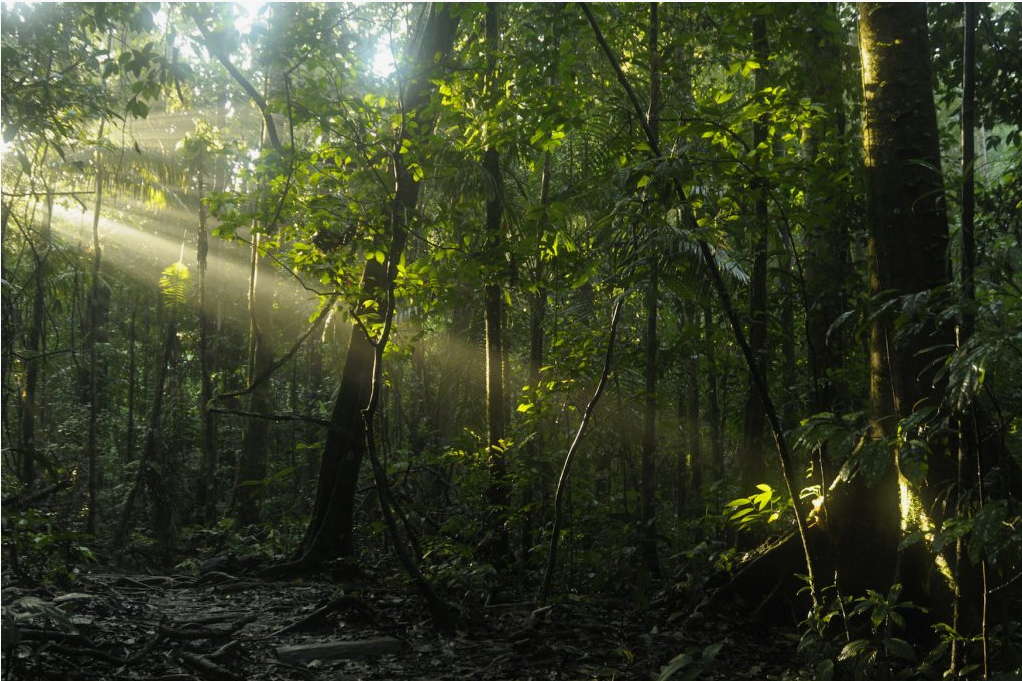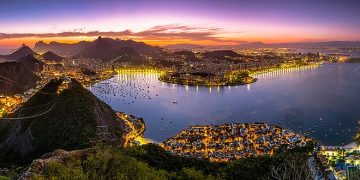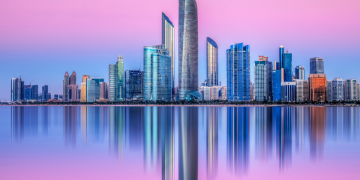In the vast expanse of South America lies hidden a mysterious and vibrant green kingdom – the Amazon Jungle, also known as the Amazon Rainforest. This vast area of about 6.6 million square kilometers (say 7 million square kilometers), spanning nine countries including Brazil, Peru, Colombia, Venezuela, Ecuador, Bolivia, Guyana, Suriname and French Guiana, is not only the largest tropical rainforest on Earth, but also the key to global biodiversity and ecosystem health. This article will explore in depth the geographical location, ecological environment, biodiversity of the Amazon jungle, as well as its important position in the Earth’s ecosystem and conservation significance.
I. Geographical location and ecological environment of the Amazon jungle
The Amazon jungle is located in the northern part of South America, its northern edge extends to the Guyana Plateau, its southern edge extends deep into the Brazilian plateau, its western edge borders the Andes Mountains, and its eastern edge reaches the Atlantic coast. This unique geographical location makes the Amazon jungle not only rich in precipitation, but also forms a complex and diverse ecosystem. In the tropical rainforest climate, the Amazon is hot and humid throughout the year, with heavy rains, the daytime temperature is about 33 degrees Celsius, and the night temperature is about 23 degrees Celsius, which provides unique conditions for the growth of all things in the jungle.
The Amazon River, the second longest river in the world, is about 6,440 kilometers long (some say 6,400 kilometers), starting in the Peruvian Andes, flowing east through the Amazon basin, and finally into the Atlantic Ocean. The Amazon and its many tributaries, such as the Madeira, not only supply the jungle with abundant water, but also form an intricate network of rivers that nourishes the vast land. The abundance of the river makes the Amazon jungle extremely humid, and the high temperatures combine to create a lush and complex ecosystem.

Biodiversity of the Amazon jungle
The Amazon jungle is known as the “lungs of the Earth” and its biodiversity is breathtaking. It is estimated that there are about 300,000 plant species in jungles, accounting for more than a tenth of the world’s plant species, including many endemic species. Among these plants, many large trees are more than 60 meters high, obscuring the sky and the sun, forming a unique canopy structure of rain forest. Under this structure, light is difficult to penetrate, making the surface plant species relatively few, but the canopy is full of vitality, a variety of vines, parasitic plants, orchids, kudana, etc., compete to grow, forming a patchwork three-dimensional landscape.
Animal resources are also rich and diverse. More than 40,000 species of vertebrates live in the Amazon jungle, including 2,500 species of fish, more than 1,600 species of birds, more than 400 species of mammals and more than 300 species of reptiles. It is not only home to star species such as jaguars, sloths and macaws, but also many species that are not fully understood by the scientific community. For example, the marmosets, which are only 10 centimeters long, the lion-headed monkeys, which have the mane of a male lion on their side, and the colorful and beautiful tropical fish are all unique creatures of the Amazon jungle.
The insect world is equally exciting. More than 2.5 million species of insects live in the Amazon jungle, including more than 700 species of butterflies, more than 600 species of beetles, and more than 400 species of ants and spiders. These insects play an important role in the ecosystem, from pollination to the decomposition of organic matter, they are indispensable.
The importance of the Amazon jungle in the Earth’s ecosystem
The Amazon jungle is not only a treasure trove of biodiversity on Earth, but also an important part of the Earth’s ecosystem, having a profound impact on the global climate, water resources and ecological balance.
Regulating climate: The Amazon jungle absorbs large amounts of carbon dioxide through photosynthesis and releases oxygen, helping to mitigate global warming. It is estimated that the Amazon rainforest contributes 20% of the total global photosynthesis and is crucial to maintaining the carbon and oxygen balance in the Earth’s atmosphere. At the same time, vegetation in jungles can also release large amounts of water vapor through transpiration, which rises with air currents to form clouds and precipitation, thereby affecting global weather patterns.
Water conservation: The Amazon River and its tributaries not only provide ample water for life in the jungle, but also an important freshwater resource in South America and the world. Jungle vegetation cover reduces surface runoff and increases groundwater storage, providing a valuable source of fresh water for the surrounding region and globally. In addition, the vegetation of the Amazon jungle can regulate the speed of water flow and reduce the occurrence of floods.
Ecological balance: The complex ecosystem of the Amazon jungle supports the survival and reproduction of many species. Plants, animals and microorganisms form a complex food chain and ecological balance relationship, and the destruction of any link may trigger a chain reaction, affecting the stability of the entire ecosystem. For example, large trees in rainforests provide habitat and food sources for many animals, and the activities of these animals promote the dispersal of plant seeds and the fertility cycle of the soil.
The positive role and conservation significance of the Amazon jungle
The Amazon jungle plays a positive role in protecting biodiversity, reducing disasters and improving the environment. However, with the continuous expansion of human activities, this green kingdom is facing unprecedented threats. Activities such as deforestation, wildfires, climate change, mineral extraction and agricultural development have severely damaged the ecological environment and biodiversity of the Amazon jungle. Therefore, it is particularly important to strengthen the protection and management of the Amazon jungle.
Conservation of biodiversity: The rich biodiversity of the Amazon jungle is a valuable natural heritage of humanity. Protecting this jungle means protecting tens of thousands of species from extinction and maintaining the stability and balance of the Earth’s ecosystems. Governments and international organizations should work together to develop and implement conservation plans to crack down on illegal logging and poaching.
Disaster risk reduction: Vegetation cover and soil water retention in the Amazon jungle are important for reducing natural disasters such as floods and droughts. Protecting the jungle can maintain the stability of the surface runoff and reduce the occurrence of soil erosion and debris flow. At the same time, the rich biodiversity of the jungle also provides a natural barrier against natural disasters.
Improve environmental quality: The green vegetation of the Amazon jungle helps to clean the air, regulate the climate and improve water quality. Protecting the jungle can reduce air pollution and water pollution, and improve the environmental quality of the surrounding region and the world. In addition, the rich medicinal plant resources in the jungle also provide mankind with a valuable source of drugs to treat various diseases.
Conservation and management cases: efforts and results in Brazil
Faced with the severe situation of the Amazon jungle, the Brazilian government has taken a series of measures in recent years to strengthen protection and management. For example, increase the number of forest protection law enforcement personnel, and prohibit the issuance of forest and land ownership certificates to those who occupy illegal land; Encourage cattle-raising to save land, and help residents switch from logging to tourism; Fund the employment of loggers engaged in forest protection work; Protect the land rights and property rights of indigenous peoples and prohibit the illegal use of indigenous lands and property; Encouraging profits from by-products rather than from deforestation, etc.

The implementation of these measures has achieved certain results. According to statistics, the rate of deforestation in the Amazon jungle has slowed in recent years, and positive progress has been made in vegetation restoration efforts in some areas. At the same time, with the increasing public awareness of environmental protection and the increasing attention of the international community, more and more companies and individuals are joining the ranks of protecting the Amazon jungle. They support the protection of the jungle through donations and volunteer services, and contribute to the future of the Amazon jungle.
Conclusion: Build a green future together
The Amazon jungle is one of the most valuable natural resources on earth, which not only has rich biodiversity and unique ecological environment, but also has a profound impact on global climate, water and ecological balance. However, with the continuous expansion of human activities and the intensification of global climate change, the Amazon jungle is facing unprecedented threats. Therefore, strengthening the protection and management of the Amazon jungle has become a shared global responsibility and mission.
We call on governments, international organizations, businesses and individuals to work together to take effective measures to protect the Amazon jungle and its biodiversity. Jointly address challenges and crises by strengthening law enforcement, promoting sustainable development models, and raising public awareness of environmental protection. Let us work together to build a green, healthy and harmonious earth home so that the Amazon jungle will always be the most beautiful scenery on earth.





















